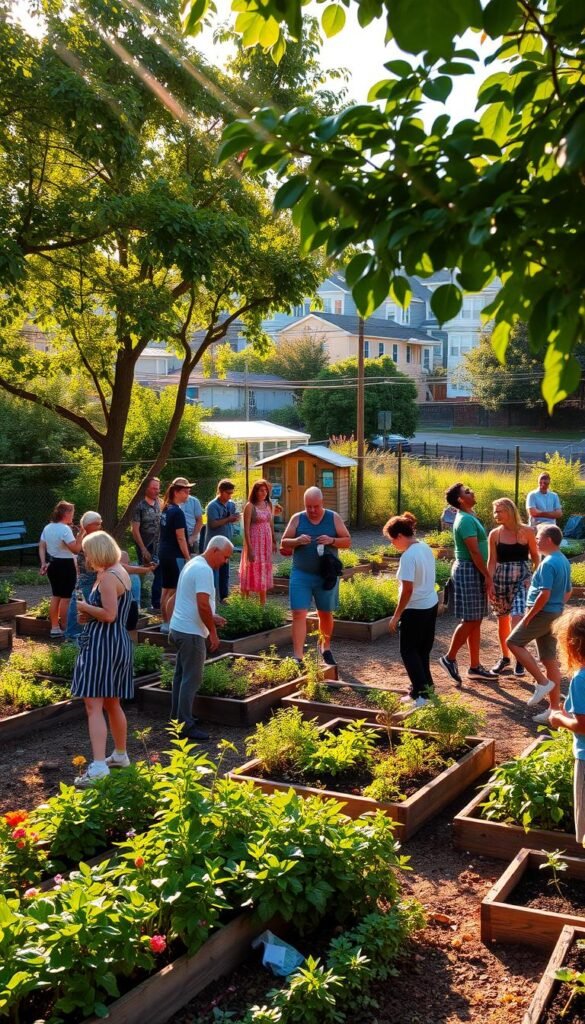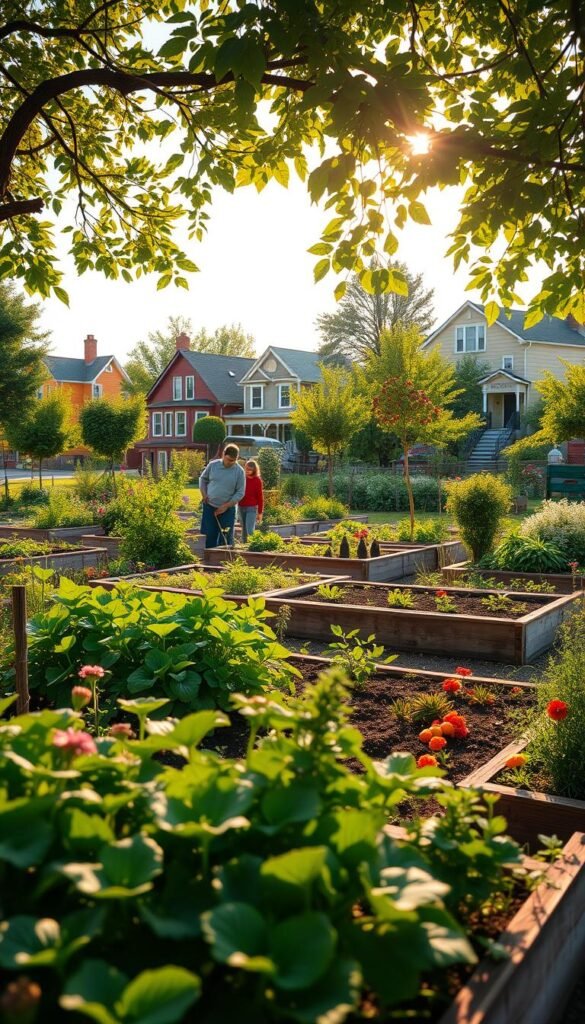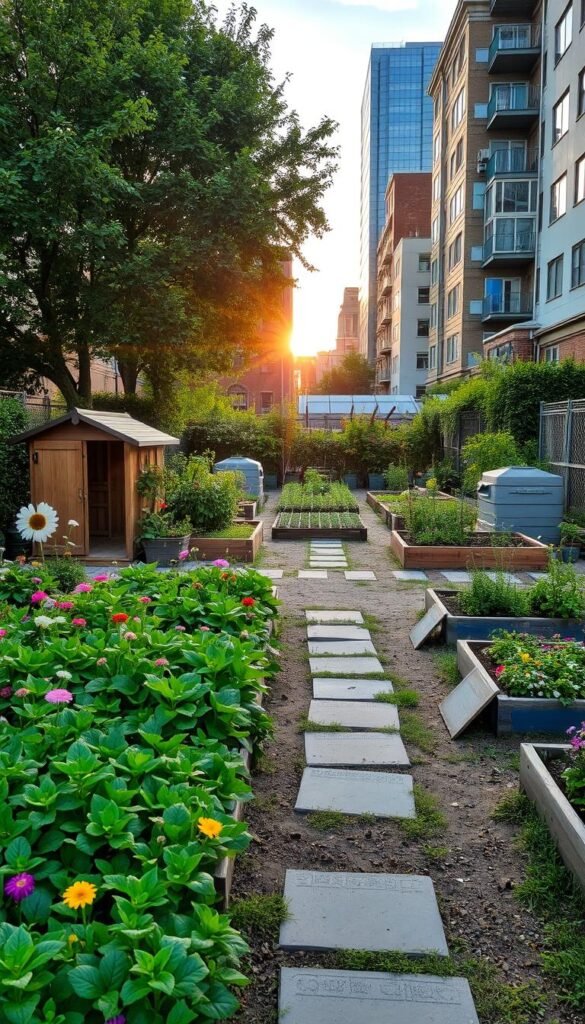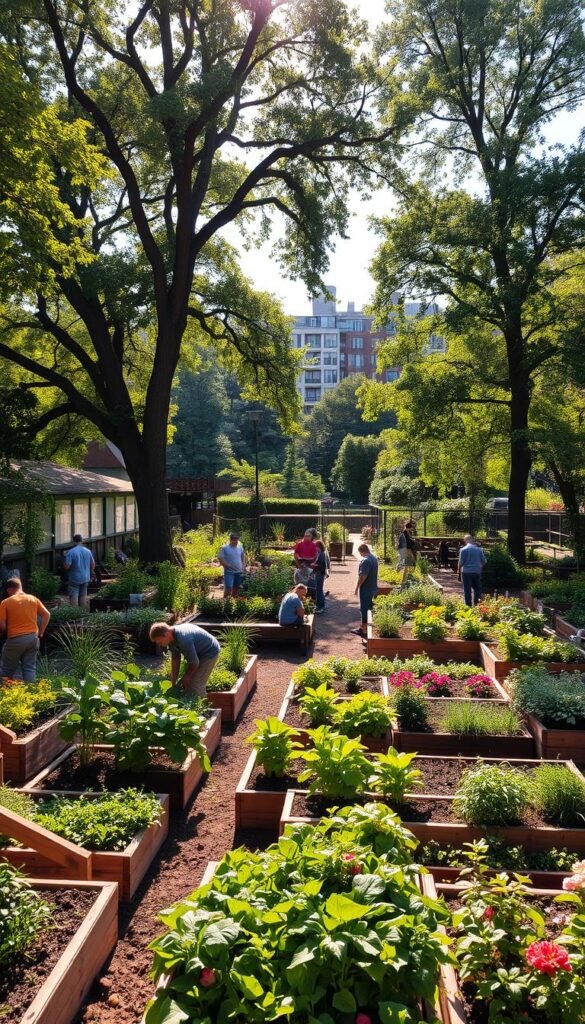Imagine transforming an empty lot or underused space into a lively hub where neighbors grow food, flowers, and friendships. Shared green spaces like these aren’t just pretty—they’re powerful tools for connection. Across the U.S., people are rediscovering the joy of digging in the dirt together while tackling food insecurity and climate concerns.
Take inspiration from groups like the Project A Seed Foundation, which helps neighborhoods turn neglected areas into thriving plots. One volunteer shared: “We didn’t just grow tomatoes—we grew trust.” These projects prove that anyone can make a difference, whether you’re planting your first seedling or organizing a team.
Urban agriculture boosts local food access and cools city heat islands. But the real magic? Watching kids taste homegrown strawberries or seniors sharing gardening wisdom across generations. Ready to roll up your sleeves? Let’s explore how to cultivate change—one seed at a time.
Understanding the Value of Community Urban Gardens

A patch of earth can become more than just soil—it’s where people grow connections alongside vegetables. These vibrant plots strengthen bonds while tackling modern challenges like food access and environmental strain. Let’s dig into why these spaces matter for both people and places.
Neighborhood Growth Beyond Plants
Shared plots create natural gathering spots where conversations bloom as easily as kale. Neighbors swap recipes with homegrown herbs or trade tips for pest control. One gardener in Detroit noted: “We’ve harvested 300 lbs of veggies this year—and countless new friendships.”
Health From the Ground Up
Getting your hands dirty literally fights stress. Studies show gardening lowers cortisol levels while providing moderate exercise. Fresh greens from these plots often become families’ first introduction to nutrient-rich meals. Proper soil preparation and smart space use ensure every seed has room to thrive.
Smart layouts with winding paths and seating areas turn functional plots into inviting retreats. Cities like Portland have seen 2-4°F temperature drops near gardens, thanks to plants absorbing heat. Rainwater soaks into raised beds instead of flooding streets, proving ecology and community can grow together.
Community Urban Gardens: How to Start or Join One in Your Neighborhood

Ready to turn that dream of fresh produce and neighborly bonds into reality? The process begins with research. Start by connecting with local extension offices or gardening nonprofits—they’ll share zoning rules and soil-testing information you need. Many cities offer free guides on starting community garden projects, complete with plant lists and layout templates.
Next, scout potential locations. Look for spaces with at least six hours of daily sunlight and easy water access. Test soil quality or plan raised beds if ground conditions aren’t ideal. As one Denver organizer advises: “Don’t fear imperfect spots—creativity thrives in challenges.”
Choose plants that match your climate and skill levels. Hardy veggies like kale or radishes work well for beginners. Partner with nurseries for discounts on seedlings, and ask experienced growers to demo proper planting techniques. Remember, every successful garden grows through trial, error, and shared laughter.
Finally, build your starter team. Host a casual meetup at a library or café to brainstorm ideas. Use free resource kits from groups like Urban Harvest to structure your planning. With the right information and enthusiasm, even a small group can cultivate big changes.
Building Your Dream Team and Garden Committee

A thriving green space starts with passionate members who bring unique skills to the table. Your committee acts as the garden’s backbone, blending vision with practical know-how. Think of it like planting a mixed crop—diversity strengthens the whole system.
Recruiting Diverse and Passionate Members
Cast a wide net when gathering your team. Post flyers at libraries, tag local social media groups, or chat with folks at farmers’ markets. One Brooklyn group recruited a retired teacher, a landscaper, and a teen coding whiz to manage their plot. “Different perspectives solve problems faster,” their coordinator notes.
Prioritize roles that match your land and goals. Need raised beds? Find carpenters. Want educational workshops? Tap educators. This table shows common roles:
| Role | Responsibilities | Skills Needed |
|---|---|---|
| Plant Expert | Select crops, troubleshoot pests | Gardening experience |
| Community Liaison | Organize events, handle sign-ups | Communication skills |
| Grant Writer | Secure funding, track budgets | Research abilities |
Empowering Local Leadership and Expertise
Let neighbors shine in their zones of genius. A Phoenix organization trained bilingual teens to lead composting demos, tripling participation. Assign clear tasks but stay flexible—sometimes the quietest member has the best irrigation hack.
Partner with schools or businesses for tools and training. One Detroit team transformed vacant land by collaborating with a hardware store for discounted materials. Remember: shared ownership keeps projects blooming year after year.
Navigating Local Regulations and Securing Crucial Resources
Turning vacant lots into green spaces requires more than soil and seeds—it needs smart navigation of local rules. Start by researching permits and lease agreements for your chosen site. Most cities have online portals listing zoning codes for urban agriculture projects.
Engaging With Local Authorities and Organizations
Visit your city’s planning department early. Bring maps of your proposed plots and ask about water access requirements. Many municipalities offer free resource packets with permit checklists. A Chicago gardener shared: “We used the city’s pre-approved garden layout template—saved us three months of paperwork.”
Confirm water sources before signing any lease. Test spigots or arrange rainwater collection systems. Some neighborhoods partner with fire departments for emergency hose access. Always get utility agreements in writing.
Finding Sponsors and In-Kind Donations
Local businesses often support green initiatives. Create a sponsorship package highlighting benefits like signage visibility. This table shows common partnerships:
| Sponsor Type | Typical Contribution | Garden Benefit |
|---|---|---|
| Hardware Stores | Tools, lumber | Raised bed materials |
| Nurseries | Seedlings, soil | Starter plants |
| Restaurants | Compost scraps | Natural fertilizer |
Offer workshops sponsored by donors—it’s a win-win. One Portland project secured free drip irrigation through a plumbing company’s community program. Remember: clear planning prevents resource gaps later. Keep records of all agreements to protect your site long-term.
Choosing and Preparing the Perfect Garden Site

The right location transforms dirt into possibility. Your site selection shapes everything from plant health to neighbor participation. Start by mapping potential areas within walking distance—empty lots, schoolyards, or even wide sidewalks.
Assessing Sunlight, Soil, and Water Access
Track sunlight patterns for three days using free apps like Sun Surveyor. Aim for spots with 6+ hours of direct light. Test soil pH with $10 kits from garden stores—most veggies thrive between 6.0-7.0. If results show contamination, build raised beds with fresh soil.
Check water access early. One Baltimore group saved $1,200 yearly by tapping into a fire hydrant permit. Always confirm utility lines before digging. As a Minneapolis gardener advises: “Dry soil grows frustration—wet roots grow results.”
Planning for Urban Space and Lease Agreements
Negotiate land use terms clearly. Many cities offer 3-year leases for $1 if you maintain the space. Get written permission even for temporary plots. Clear debris first—rent a dumpster or host a cleanup day with pizza incentives.
Sketch your layout to maximize growing areas. Leave 4-foot-wide paths for wheelbarrows. Partner with cafes for compost donations to enrich soil naturally. Remember: every shovel strike builds something bigger than a garden.
Designing a Personalized Garden Layout for Community Success

Your garden’s blueprint becomes its beating heart—where function meets community spirit. Smart layouts do more than organize plants; they create spaces for learning, sharing, and celebration. Think of pathways as conversation starters and plots as personal canvases.
Optimizing Pathways, Plots, and Community Areas
Start by mapping three zones: growing areas, walkways, and gathering spots. Keep paths 3-4 feet wide for wheelbarrows and strollers. Use recycled bricks or wood chips to define routes naturally. In Seattle, one group transformed shipping pallets into movable seating between plots—doubling as both furniture and shade structures.
Allocate 60% of space to individual beds and 40% to shared features like compost stations or herb spirals. A Portland team staggered planting times so flowers always bloom near benches. “We wanted beauty where people pause,” explains their lead designer.
Incorporating Creative and Sustainable Design Elements
Turn everyday items into garden art. Old tires become potato planters, while bottle caps mosaic garden signs. Install rain barrels painted by local artists—functional and eye-catching. For soil health, try lasagna gardening: layering cardboard, leaves, and compost directly on grass.
Follow these steps to refine your design:
- Sketch drafts using free online tools like Garden Planner
- Host a “design charrette” where volunteers rearrange paper cutouts
- Test layouts with potted plants before finalizing
Remember: Great planning leaves room for surprises. When Austin gardeners found extra bricks, they built a sundial centerpiece. Your starting community garden layout isn’t set in stone—it’s a living map that grows with your neighborhood’s dreams.
Tips for Long-Term Garden Maintenance and Community Engagement
Keeping a shared green space thriving requires more than just planting seeds—it’s about nurturing relationships and resources season after season. Successful plots blend consistent care with creative outreach to stay vibrant for years.
Encouraging Volunteer Participation and Ongoing Care
Turn casual helpers into dedicated stewards with clear roles. Create a “skill share” board where volunteers sign up for tasks matching their strengths—like pruning experts teaching workshops or artists designing signage. Track soil health and pest patterns using shared digital calendars.
Host monthly workdays with themes: “Pizza & Pruning Saturdays” or “Sunset Weeding Wednesdays.” A Oakland group increased turnout by 70% using this approach. Recognize contributions through harvest swaps or featured gardener spotlights on social media.
Managing Funding and Evolving Garden Needs
Diversify income streams to weather unexpected challenges. Partner with organizations for grant opportunities, and host donation-based plant sales. One Milwaukee coalition funds tools through a project-sponsor program where businesses adopt raised beds.
Revisit your budget quarterly. Allocate funds for:
- Soil testing and amendments
- Tool replacements
- Educational materials
Adapt layouts as people’s needs change—convert shaded areas into seating nooks during heatwaves. As a Denver leader notes: “Our compost station became a popular coffee chat spot—we added benches and Wi-Fi!”
Build resilience by training multiple gardeners in key roles. Document processes in shared drives so knowledge outlasts individual members. With thoughtful planning, your green oasis becomes a lasting legacy.
Harvesting Rewards and Celebrating Your Community Garden Journey
The first ripe tomato plucked from shared soil marks more than a harvest—it’s proof that small actions grow into something extraordinary. Through the process of planning and planting, you’ve cultivated fresh food and deeper bonds. Celebrate by hosting a “tasting night” where gardeners turn produce into shared meals, or organize seed-saving workshops to prepare for next season.
Success stories abound: A Seattle group donated 800 lbs of veggies to food banks last year while reducing their city’s heat index. Your efforts similarly transform spaces into engines of urban agriculture, cleaning air and cooling streets. Even simple milestones matter—a child’s first homegrown carrot or seniors swapping heirloom recipes deserve recognition.
Share your wins to spark interest! Post photos of vibrant harvests or creative garden art on local forums. Many find that discover more strategies for maintaining momentum through seasonal challenges. These green spaces clean air, reduce urban heat, and even lower crime rates by fostering connections.
Every planted seed strengthens your neighborhood’s roots. As you reflect on growth—both in soil and spirit—remember: this isn’t an endpoint, but the start of endless possibilities. What will your successful community grow next?






